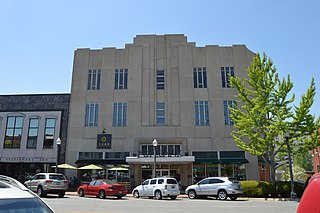
The Court House Hill–Downtown Historic District is a national historic district located in Lynchburg, Virginia. The area is situated on a promontory overlooking the Lower Basin Historic District on the south bank of the James River. The approximately 50-acre (200,000 m2) district is composed of relatively intact city blocks of religious, commercial, residential, and governmental buildings and structures ranging in date from the early 19th century to the mid-20th century. Buildings in the district represent a variety of styles from the different periods, including the Federal, Greek Revival, Gothic Revival, Italianate, Queen Anne, Neoclassical, Italian Renaissance, Spanish Eclectic, Craftsman, and Art Deco styles.

The Old Greene County Courthouse is a historic courthouse in Eutaw, Alabama, United States. It housed the seat of government for Greene County from 1869 until 1993. The building is a two-story masonry structure in the Greek Revival style with Italianate influences. Architect Clay Lancaster proposed that it may be the last Greek Revival public building to be built in Alabama. It replaced an earlier wooden courthouse on the same site that was built in 1838. The prior courthouse was burned in 1868, in what is considered by most historians to have been a deliberate act of arson that was executed to destroy indictments brought by the recently installed Radical Reconstruction government against local citizens. The fire destroyed paperwork pertaining to some 1,800 suits by freedmen against planters which were about to be acted on. The courthouse was placed on the National Register of Historic Places on March 24, 1971, due to its architectural significance.
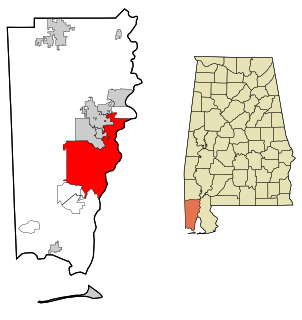
This is a list of the National Register of Historic Places listings in Mobile, Alabama.

Valparaiso has retained an active downtown. It remains a mix of government, retail and business center, with a mixed residential and service area. Numerous economic changes have not changed the basic character, historic courthouse area. The historic district retains the distinctive turn-of-the-19th-century architecture, supporting numerous small specialty shops, shaded sidewalks, and a people friendly environment. The Downtown District, is anchored on the Porter County Courthouse. It includes 14-blocks surrounding the square, bounded on the north by Jefferson Street, on the east by Morgan Street, on the south by Monroe Street, and on the west by Napoleon Street.

The Central Geneva Historic District is a set of 102 buildings and structures in Geneva, Illinois. Of those, 68 contribute to the district's historical integrity. The district is representative of southern Geneva, south of Illinois Route 38. Among the noted buildings is the Kane County Courthouse and the Frank Lloyd Wright-designed P. D. Hoyt House. The district was added to the National Register of Historic Places in 1979, and was enlarged in 2017.

The Meigs County Courthouse is a local government building in Pomeroy, Ohio, United States. Built in the 1840s in this Ohio River village, it serves as the seat of government for Meigs County, and it is one of Ohio's oldest courthouses still used for its original purpose.

The John Archibald Campbell United States Courthouse, also known as the United States Court House and Custom House, is a historic courthouse and former custom house in Mobile, Alabama. It was completed in 1935. An addition to the west was completed in 1940. It was added to the National Register of Historic Places on October 8, 2008.

The Morris Downtown Commercial Historic District is a historic district in downtown Morris. The district includes 116 buildings and a monument; 105 of these are commercial buildings, and 87 are contributing properties to the district.

The Jefferson County Courthouse in Birmingham, Alabama is the main county courthouse of Jefferson County, Alabama. It is the county's sixth main courthouse building, and the third in Birmingham. The cornerstone was laid in 1929, and the building was completed in 1932. The prior courthouse was demolished in 1937. The new courthouse was added to the National Register of Historic Places in 1982.

The Marshall Business Historic District is a historic district located in downtown Marshall, Illinois. The district encompasses the city's historic commercial center and includes 56 buildings and structures, 46 of which are contributing buildings. Marshall's courthouse square is a central feature of the district; the square includes the Italian Renaissance Revival Clark County Courthouse, which was built in 1903. The other buildings in the district, mainly commercial and government buildings, were built from the 1830s to the 1960s; however, most of the buildings were built between 1870 and 1910, Marshall's largest growth period. The buildings from this era are mostly designed in the Italianate, Romanesque, and Italian Renaissance Revival styles.
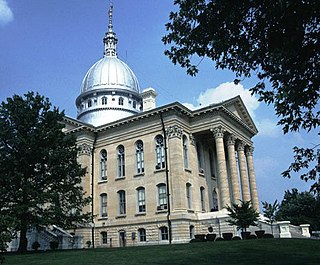
The Carlinville Historic District includes the oldest sections of Carlinville, Illinois. The district consists of much of central and eastern Carlinville and is roughly bounded by Oak Street, Mulberry Street, Morgan Street, and the eastern city limits. The Macoupin County Courthouse, a Beaux-Arts building built in 1867-70, is the focal point of the district. The courthouse is situated in a public square in downtown Carlinville and is surrounded by some of the city's oldest businesses. The district also includes large residential sections; popular architectural styles in these areas include Federal, Greek Revival, Italianate, and Queen Anne.
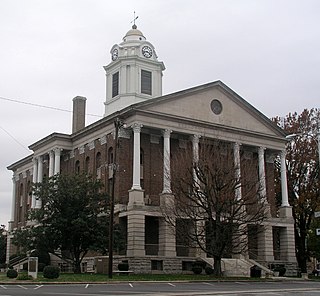
The Shelbyville Courthouse Square Historic District is a historic district in Shelbyville, Tennessee, centered on the Bedford County Courthouse Square.
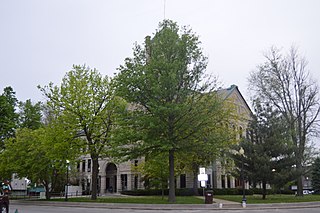
The Taylorville Courthouse Square Historic District is a 19.7-acre (8.0 ha) historic district located in downtown Taylorville, Illinois. The district encompasses most of Taylorville's downtown business center; while it is primarily commercial, it also includes several important government buildings. The Christian County Courthouse, a Romanesque building constructed in 1902, forms the centerpiece of the district. While development in the district began in the late 1830s, only two buildings in the district predate 1875. The first major growth period represented in the district occurred from 1875 to 1900; the commercial buildings from this period feature Italianate, Romanesque, Beaux-Arts, and Queen Anne designs. Another period of construction followed the courthouse's opening; in the ensuing decades, several Classical Revival and Prairie School buildings opened, as did the Mission Revival public library. Since 1935, the district has remained largely intact.
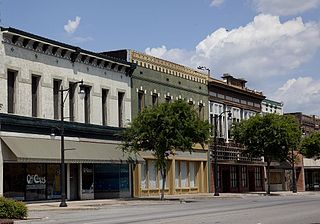
The Gadsden Downtown Historic District is a historic district in Gadsden, Alabama. The district represents the growth of the town through its industrial heyday from the late 1870s to the late 1940s. The earliest buildings in the district include examples of highly decorated Italianate styles, including the 1904 Gadsden Times-News Building. Early 20th-century buildings began showing less applied decoration, instead drawing visual variety from the brickwork itself. Later buildings begin to incorporate modern materials in their construction, including concrete, decorative glass, and enameled panels. There are three significant churches in the district that represent revivalist architectural styles:the Gothic Revival First Methodist Church, the Neoclassical First Baptist Church, and the Romanesque St. James Catholic Church. The Post Office and Courthouse, built in 1910, exhibits Italian Renaissance Revival style. The district was listed on the National Register of Historic Places in 1997.

Morganton Downtown Historic District is a national historic district located at Morganton, Burke County, North Carolina. It encompasses 62 contributing buildings in the central business district of Morganton. It includes commercial, industrial, and governmental buildings built between about 1889 and 1940. It includes representative examples of Classical Revival, Art Deco, and Italianate style architecture. Notable buildings include the Old Burke County Courthouse, Morganton Post Office, and the Morganton Community House.

The Monticello Courthouse Square Historic District is a historic district in downtown Monticello, Illinois. The district includes the historic commercial center of the city, the county seat of Piatt County, and is centered on the Piatt County Courthouse. 80 buildings are included in the district, 73 of which are considered contributing to its historic character. The district was added to the National Register of Historic Places on November 5, 2009.

The Moulton Courthouse Square Historic District is a historic district in Moulton, Alabama. Moulton's development began in 1820, when it was chosen as the county seat of the newly formed Lawrence County. The first courthouse was a log structure; a log jail on the west side of the square operated until 1911, when it was replaced with the current, 3-story brick jail and courthouse annex. Due to its lack of rail and river connections, development around the square remained sparse. The log courthouse was replaced in 1860 with a two-story, square building with Classical Revival details. The cotton economy of Lawrence County rebounded after the Civil War with the construction of several cotton gins, though nearly all of the structures built along the square in the late 19th century were later razed and replaced. The oldest extant buildings in the district were built in 1911: the three-story courthouse annex, and the two-story, stone faced Citizens' Bank building. The northern part of Market Street, on the west side of the square, were constructed during the early 1920s. Lawrence County's economy received a boost from New Deal programs, most notably the Tennessee Valley Authority's fertilizer program and construction of Wheeler Dam. Most of the square's buildings were constructed during the late 1930s and 1940s, in contrast to most historic downtowns around the South. The current courthouse was completed in 1936. The district was listed on the National Register of Historic Places in 1998.

Downtown Durham Historic District is a national historic district located at Durham, Durham County, North Carolina. The district encompasses 97 contributing buildings and 1 contributing structure in the central business district of Durham. The buildings primarily date from the first four decades of the 20th century and include notable examples of Colonial Revival, Italianate, and Art Deco architecture. Notable buildings include the St. Philip's Episcopal Church (1907), Trinity Methodist Episcopal Church (1880-1881), First Baptist Church (1926-1927), Durham County Courthouse (1916), Durham Auditorium, Tempest Building, National Guard Armory (1934-1937), United States Post Office (1934), Trust Building (1904), First National Bank Building (1913-1915), Mechanics and Farmers Bank (1921), Johnson Motor Company showroom (1927), Hill Building (1935), Snow Building (1933), and S. H. Kress store.

The Monmouth Courthouse Commercial Historic District is a historic district located in downtown Monmouth, Illinois. The district encompasses Monmouth's historic commercial core and includes 63 contributing buildings and sites, most of them commercial buildings. Growth in the district began in the 1850s and continued through the 1920s, with occasional spurts in between due to rebuilding after fires. The Public Square, a small park within a roundabout, serves as the anchor of the district; the Warren County Courthouse, a Richardsonian Romanesque building completed in 1895, is its namesake building. Most of the commercial buildings within the district have Italianate or Commercial Style designs, with the former style generally predating the latter. Examples of the Queen Anne, Classical Revival, Art Deco, and Moderne styles can also be seen in the district.

The Downtown Douglas Historic District is located in Douglas, Georgia and was added to the National Register of Historic Places in 1993. It is roughly bounded by Jackson Street, Pearl Avenue, Cherry Street, and the Georgia-Florida Railroad.






